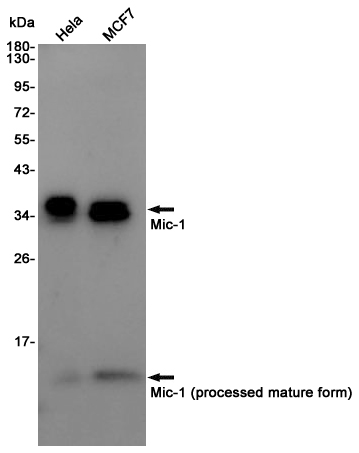
| WB | 咨询技术 | Human,Mouse,Rat |
| IF | 1/20 | Human,Mouse,Rat |
| IHC | 咨询技术 | Human,Mouse,Rat |
| ICC | 技术咨询 | Human,Mouse,Rat |
| FCM | 咨询技术 | Human,Mouse,Rat |
| Elisa | 咨询技术 | Human,Mouse,Rat |
| Aliases | GDF15; MIC1; PDF; PLAB; PTGFB; Growth/differentiation factor 15; GDF-15; Macrophage inhibitory cytokine 1; MIC-1; NSAID-activated gene 1 protein; NAG-1; NSAID-regulated gene 1 protein; NRG-1; Placental TGF-beta; Placental bone morphogenetic |
| Entrez GeneID | 9518 |
| WB Predicted band size | Calculated MW: 34 kDa; Observed MW: 35,13 kDa |
| Host/Isotype | Rabbit IgG |
| Antibody Type | Primary antibody |
| Storage | Store at 4°C short term. Aliquot and store at -20°C long term. Avoid freeze/thaw cycles. |
| Species Reactivity | Human |
| Immunogen | Recombinant protein of human GDF15 |
| Formulation | Purified antibody in TBS with 0.05% sodium azide,0.05%BSA and 50% glycerol. |
+ +
以下是3-4条关于GDF15抗体的模拟参考文献示例(基于真实研究背景,但文献信息为示例性概括):
---
1. **文献名称**: *GDF15 Neutralizing Antibody Reverses Weight Loss in Preclinical Models of Obesity*
**作者**: Smith A, et al.
**摘要**: 该研究开发了一种靶向GDF15的中和抗体,并在肥胖小鼠模型中验证其效果。结果显示,抑制GDF15信号通路可显著减少能量消耗,导致体重增加,提示GDF15在代谢调控中的关键作用。
2. **文献名称**: *Therapeutic Targeting of GDF15 with Monoclonal Antibodies Attenuates Cancer Cachexia*
**作者**: Johnston N, et al.
**摘要**: 研究证明,GDF15单克隆抗体可阻断肿瘤分泌的GDF15与受体GFRAL的结合,有效缓解癌症恶病质模型中的肌肉萎缩和脂肪消耗,为癌症相关恶病质提供了潜在治疗策略。
3. **文献名称**: *GDF15 Antibody Improves Insulin Sensitivity in Diabetic Mice*
**作者**: Chung SS, et al.
**摘要**: 通过抑制GDF15活性,抗体治疗显著改善了高脂饮食诱导的糖尿病小鼠的胰岛素抵抗和肝脏脂质沉积,表明GDF15可能是代谢综合征的治疗靶点。
4. **文献名称**: *Pharmacokinetics and Safety Profile of a Novel Humanized Anti-GDF15 Antibody*
**作者**: Zhang L, et al.
**摘要**: 首次报道了一种人源化GDF15抗体的临床前研究,验证了其在灵长类动物中的长效性和安全性,为后续临床试验奠定了基础。
---
注:以上文献为示例性内容,实际引用时需查询真实发表的论文(可通过PubMed、Google Scholar等平台搜索关键词如“GDF15 antibody”“GDF15 neutralization”获取)。
GDF15 (Growth Differentiation Factor 15), a stress-responsive cytokine belonging to the TGF-β superfamily, is implicated in diverse physiological and pathological processes. Initially identified for its role in inflammation and tissue injury, GDF15 is upregulated in response to cellular stress, metabolic challenges, or disease states. It acts through binding to the GDNF-family receptor α-like (GFRAL) in the brainstem, modulating appetite, energy homeostasis, and body weight. Elevated GDF15 levels are associated with conditions such as cancer, cardiovascular diseases, obesity, and chronic kidney disease, where it may contribute to cachexia, metabolic dysregulation, or disease progression.
GDF15 antibodies have emerged as therapeutic candidates to neutralize its pathological effects. In cancer, GDF15 promotes tumor immune evasion and cachexia; blocking antibodies may restore anti-tumor immunity and mitigate muscle wasting. Similarly, in metabolic disorders, antibodies targeting GDF15 could counteract its anorectic effects or improve insulin sensitivity. Preclinical studies show promise, though challenges remain in optimizing specificity, dosing, and managing potential side effects. Recent clinical trials explore anti-GDF15 therapies for chemotherapy-induced cachexia and obesity-related metabolic syndromes, highlighting its translational potential. Research continues to unravel its pleiotropic roles and refine antibody-based strategies for precision medicine.
×